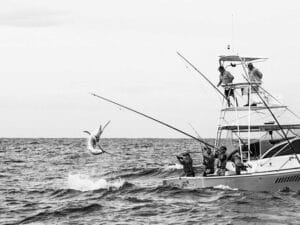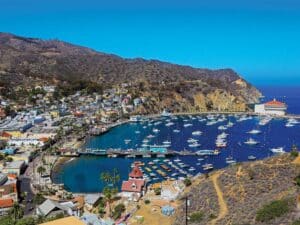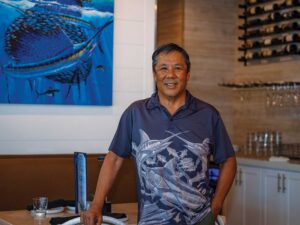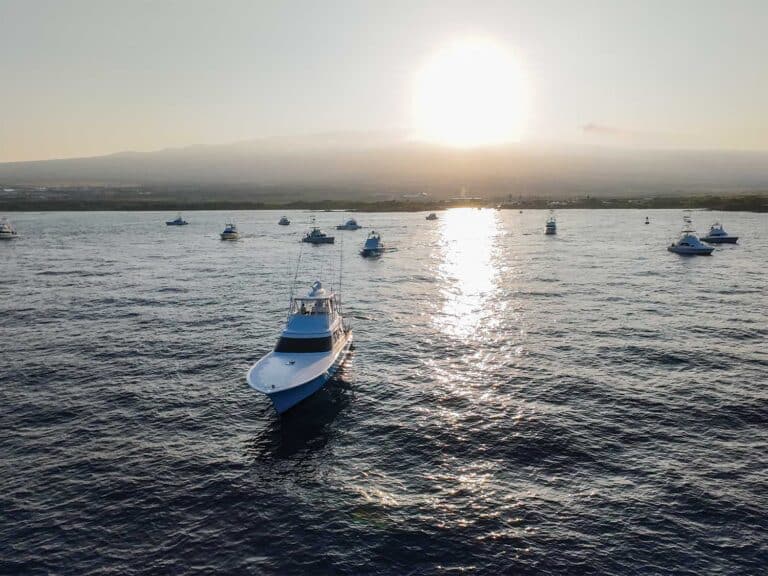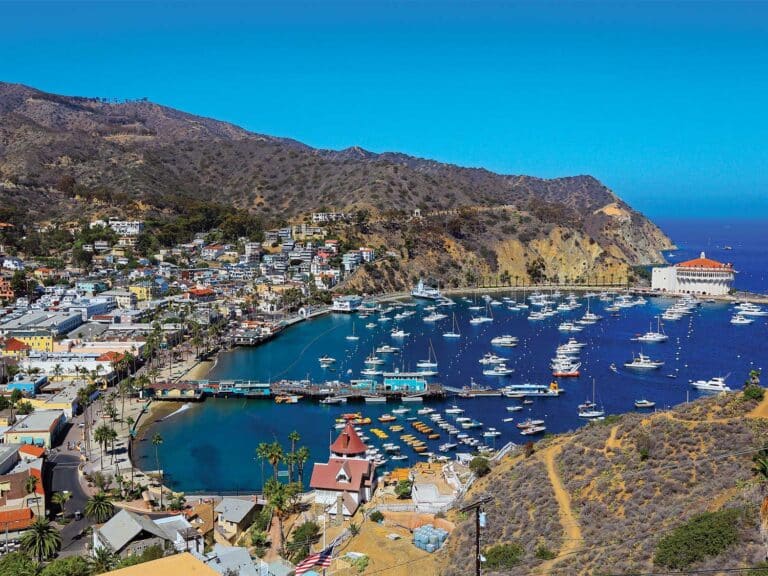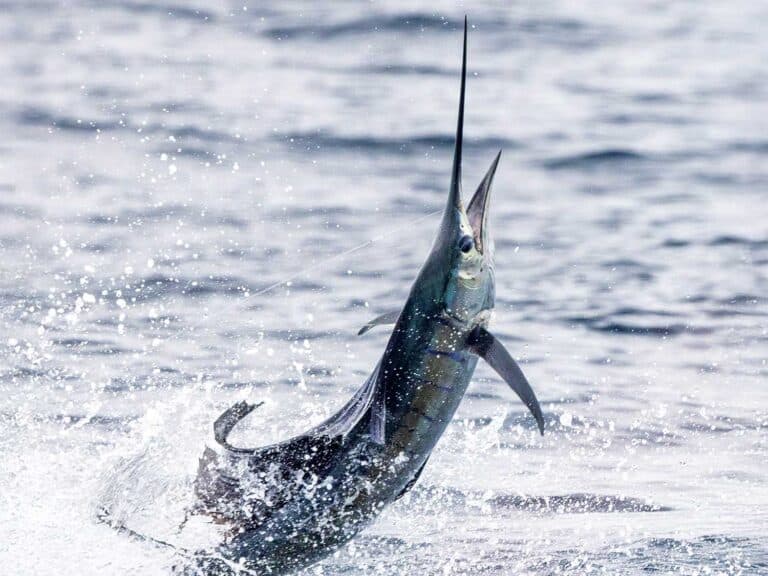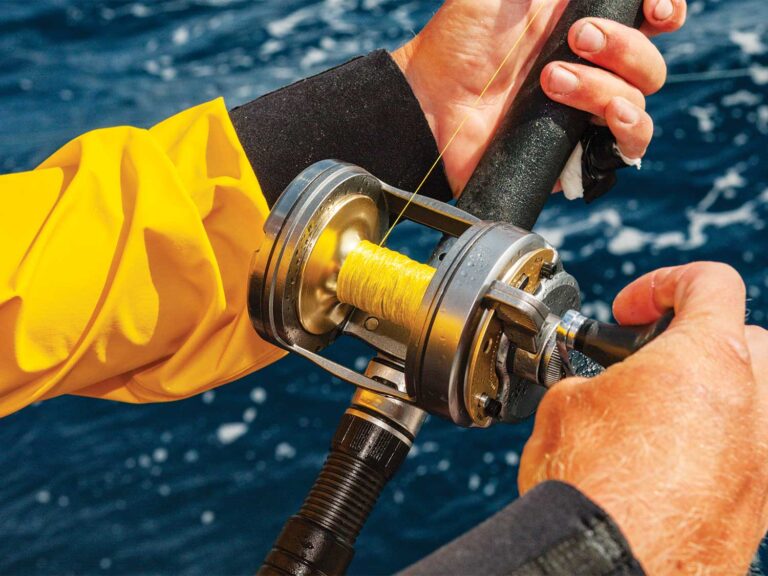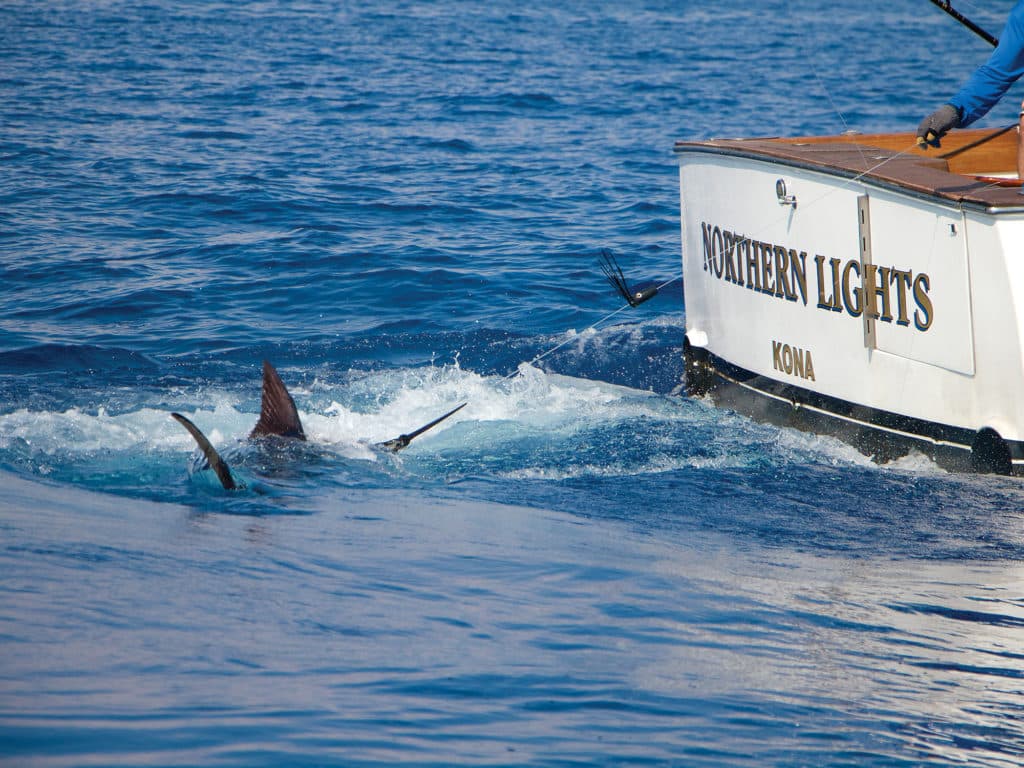
Hawaii’s 62-year narrative about grander blue marlin catches began in November 1954 when Capt. George Parker Jr. set out alone from Kona to dry-dock his 47-foot charter boat, Mona H, in Honolulu. He towed a homemade chrome-on-wood tube lure with a slanted flat face in his wake. The lure was his own custom design that he made by force-fitting a wooden dowel inside a section of a chrome plumbing fixture that he had cut, and then he skirted it with Naugahyde pendants and rubber strips. Back then, lure fishing for marlin was virtually unheard of outside Hawaii, so the lure was a novelty in the world of big-game fishing. Indeed, the saga of Hawaii’s granders is also the story of the development and worldwide acceptance of Hawaiian-style trolling lures for blue marlin.
The First Grander
By the time Parker reached the waters off Diamond Head, he had already caught a mahimahi and lost a marlin. The lure was swimming well with a lot of flash and just the right amount of billfish-attracting splash. That’s when a 1,002‑pound blue marlin jumped on the lure and started ripping 130-pound Dacron line from the 14/0 Penn Senator reel and smoked the drag. When he realized he couldn’t maneuver the boat and gain line on the fish, he radioed for help. Three other fishermen fishing in the area answered the call, jumped aboard, and took over deck duties while Parker pumped and reeled. Three and a half hours later and in the gathering darkness, the fish made one final lunge at the boat, and the historic battle was over.
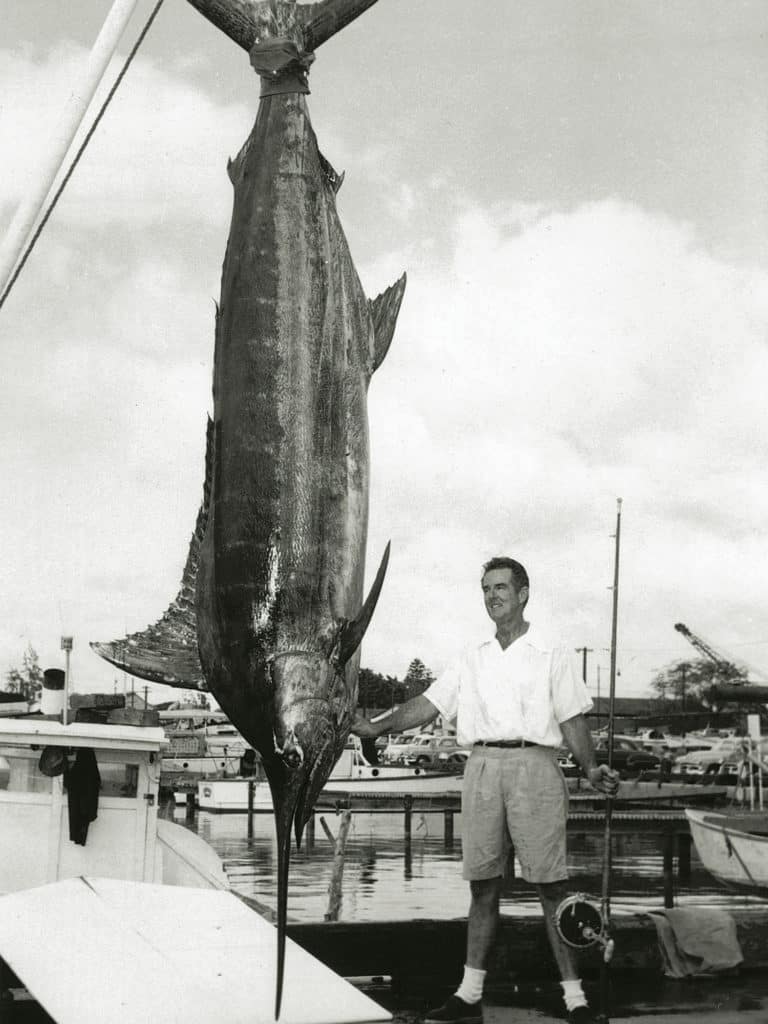
Images of the 1,002-pound fish hanging at the Honolulu scales flashed around the world and made magazine covers on the U.S. mainland. The lure itself got little or no attention because it was an aberration in a fishing tradition that believed you could only catch billfish on carefully rigged fresh baits. Parker’s wooden lures were crude creations at best, but his fishing neighbor in Kona, Capt. Henry Chee, had already begun to make alternatives that were as attractive to fishermen as Hawaii’s anglers knew they were to fish. Chee was molding his “straight runner” tube lures in glass tumblers using plastic resin surrounding polished strips of pearl shell. Chee’s slant-faced lures quickly took over the Kona fishing scene even though the innovative skipper wouldn’t catch his first grander on one until boating a 1,095-pound blue in 1964.
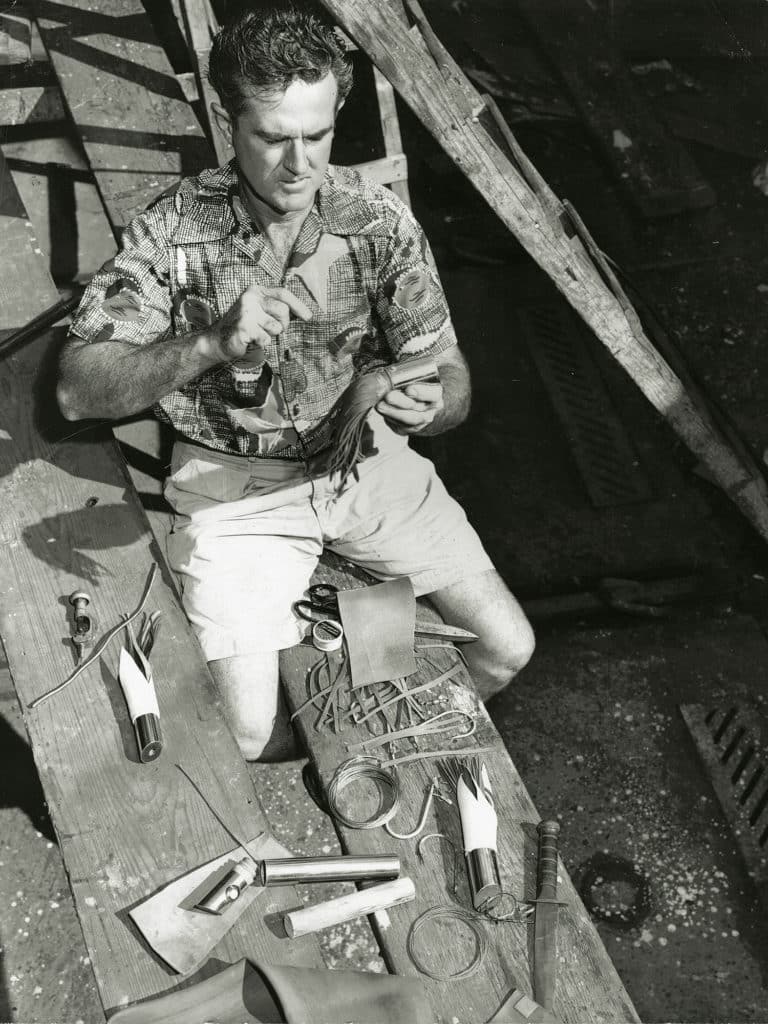
A Growing Trend
Meanwhile, the trick of molding marlin lures in casting resin was going in another direction off the island of Oahu. Though Kona’s calm waters were ideal for the center-pull, flat-faced straight runners, the bumpy trade-wind seas elsewhere in the islands stirred the imaginations of other lure makers to create models with curvaceous bodies, scooped faces and off-center leader holes. Most notable of these were models made by Honolulu craftsmen George Lum, Johnny Abreu and Chester Kaita. In 1962, a Lum scoop-faced “bait” even made it all the way to Hatteras, North Carolina, where the crew on the charter boat Albatross used it to catch an 810-pound blue to set the Atlantic blue marlin record. The lure was virtually ignored in stories about the historic catch — even up to today.
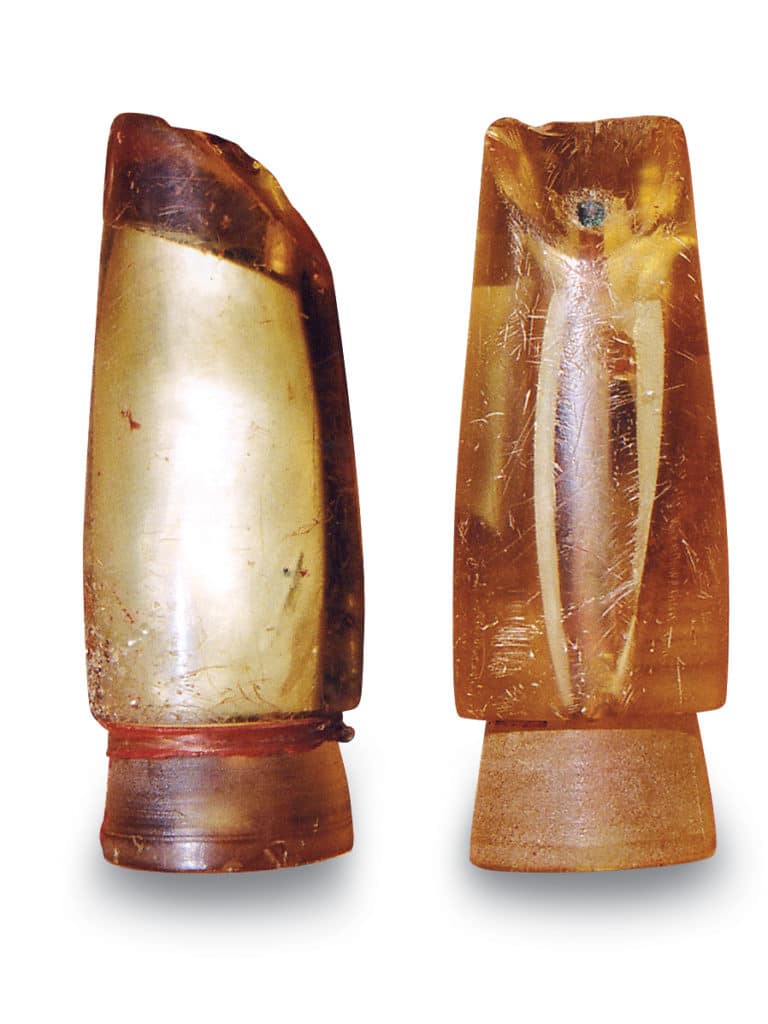
No one ignored the next great Lum lure catch though, then or since. Hawaii’s trollers had been scoring a few thousand-pounders a year throughout the 1960s without much notice elsewhere — the term “grander” wasn’t coined until the 1970s. But that all changed in June 1970 when Honolulu Capt. Cornelius Choy stunned the world with a blue marlin that weighed 1,805 pounds. Despite its monumental size, Choy’s Monster didn’t make the record books because several anglers traded rod and reel duties during the eight-hour fight. At one point, the fish pulled free but remained motionless on the surface until Choy reversed the Coreene C so his daughter Gail could gaff it.
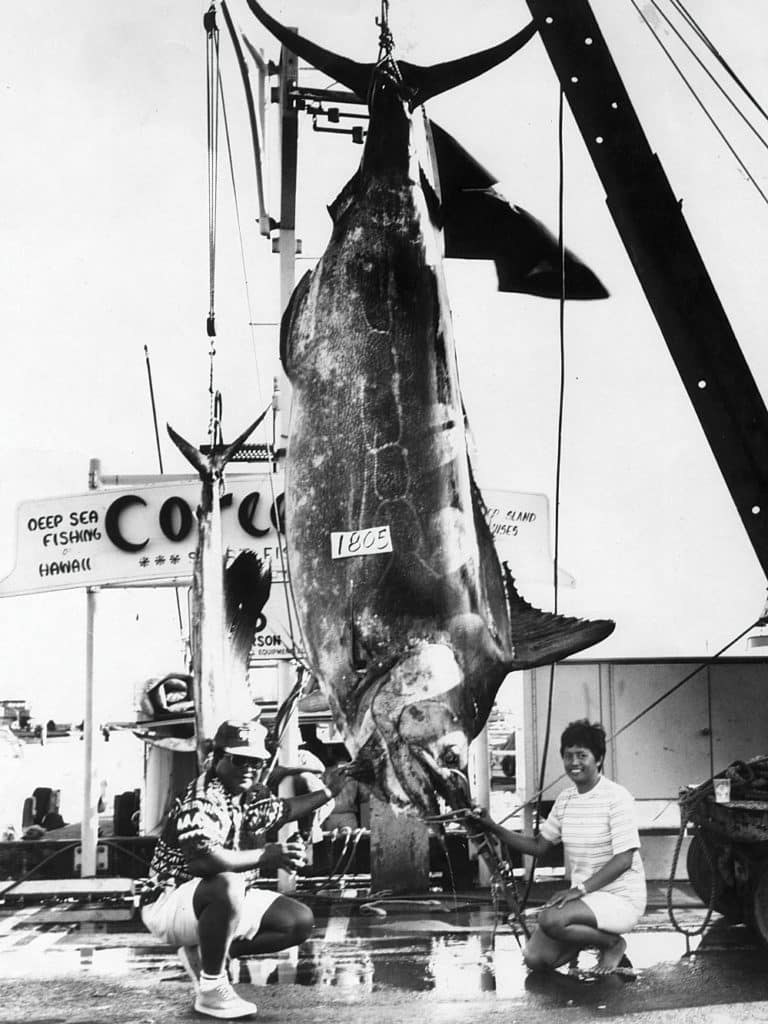
Before Choy caught the 1,805-pound giant, fishing experts thought that blues didn’t grow as big as blacks. Believe it or not, George Parker’s historic 1,002-pound blue was originally identified as a black until Parker mounted a legal challenge to have it properly identified. Hawaii’s grander blue marlin were teaching fishermen and scientists new things about the world’s amazing billfish species.
Record Breakers
Despite the stunning success of Hawaiian-style trolling lures in the central Pacific, anglers elsewhere resisted adopting them for at least another decade. Hawaii’s list of granders kept growing by two or three a year until 1978 when the Kona fleet recorded six in a single year. During the 1970s, lure makers began experimenting with a promising new shape that combined the center-pull, slant-faced tube lure with a curved body similar to those usually seen on the Honolulu scoop-faced lures. Kona’s Capt. Gene Vander Hoek is most often associated with this hybrid, which became known as the plunger. Lure maker David Kaita (son of legendary lure maker Chester Kaita) turned out a blue plunger for Capt. Bobby Brown and watched it make history in 1982 when Brown used it to set the IGFA 130-pound-class record with a 1,376-pound blue. Brown’s record still stands. Kona’s granders now hold the IGFA 30-, 50- and 130-pound-class records, and a grander caught off Honolulu holds the men’s junior record.
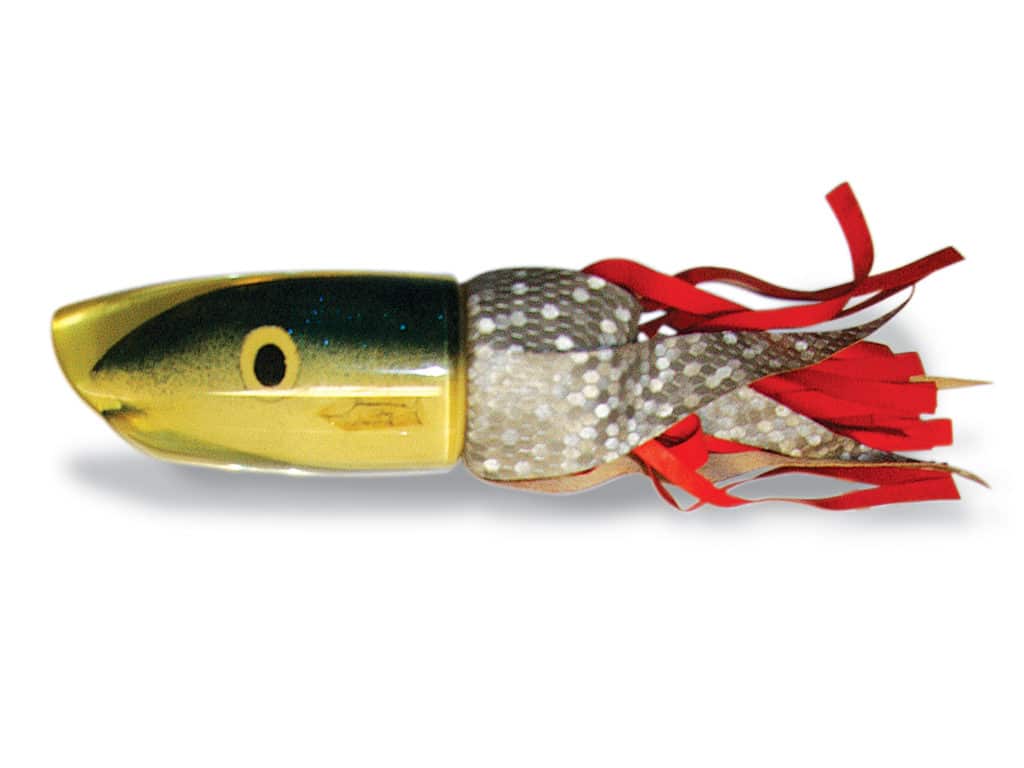
A Growing Stable of Lure Makers
In 1984, Capt. Bart Miller caught the world’s attention again when he used a plunger-style lure from his own shop to bring a 1,649-pound blue marlin to the Kona scales. The fish was originally assigned a weight of 1,656 pounds, but the weigh master corrected it hours later after he realized that an additional 7-pound support rope was added while they were weighing the fish after the scale had already been zeroed out.
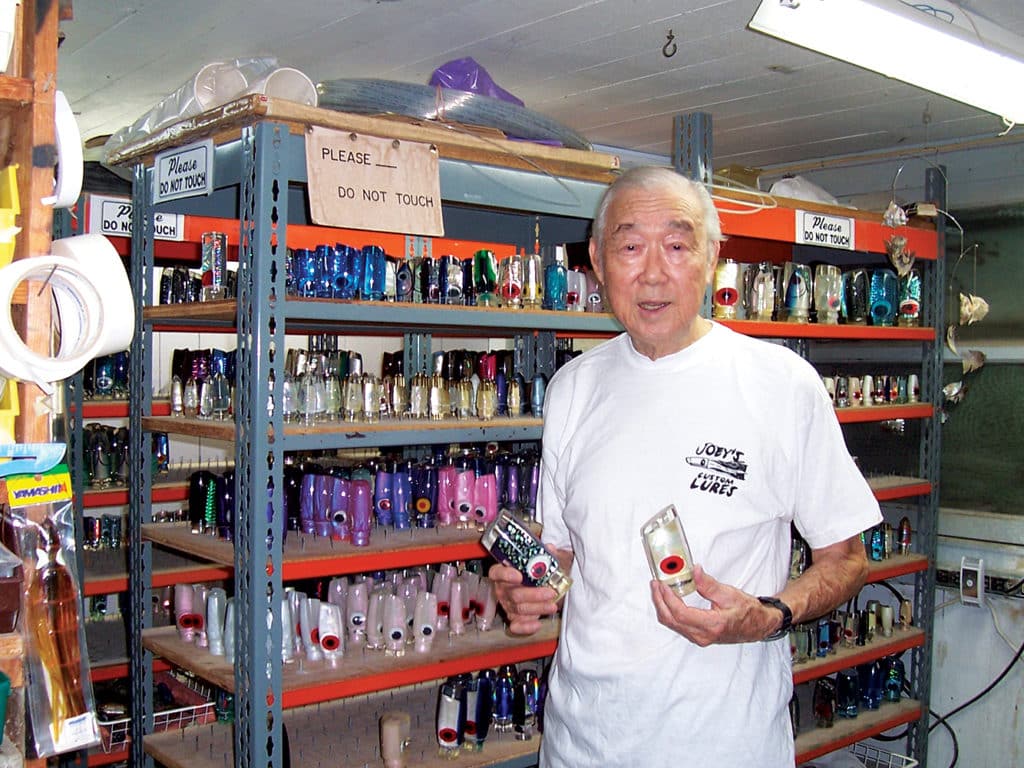
A year later in 1985 at the urging of Capt. Peter Hoogs, who caught one of the granders in 1978, Honolulu lure maker Joe Yee copied the plunger shape in a larger size. Yee’s Superplunger immediately caught a 1,183-pound blue for Capt. Jerome Judd. Not only did the lure go on to become one of Hawaii’s most successful grander catchers of all time, it helped establish trolling with Hawaiian-style lures as the standard blue marlin fishing method everywhere in the world.
Parker’s sons, Marlin and Randy, carried on the family fishing tradition and have outdone their dad by catching two granders each in their careers as captains. Marlin continued Parker’s interest in lure development through his Marlin Magic line of trolling lures, which are proven grander catchers in Hawaii and elsewhere.
Yee’s Superplunger immediately caught a 1,183-pound blue for Capt. Jerome Judd. Not only did the lure go on to become one of Hawaii’s most successful grander catchers of all time, it helped establish trolling with Hawaiian-style lures as the standard blue marlin fishing method everywhere in the world.
Today, lures by Joe Yee, Bart Miller (Black Bart) and Marlin Parker (Marlin Magic) are now the gold standard wherever anglers target blue marlin, but a new generation of Hawaiian innovators has added their names to the honor roll. The constellation of creative stars now include classics like Capt. Erik Rusnak’s (Aloha Lures) Smash Bait, Eric Koyanagi’s (Koya Lures) Poi Dog and Capt. Bomboy Llanes’ (Bomboy’s Lures) Straight Runner, which have all caught granders.
Big Fish, Small Boats
Hawaii’s grander list now includes up to 200 blues, not counting many that were released. Hawaii’s pros follow the rule “don’t say it if you don’t weigh it.” So no one really knows how many have really been caught, including true giants that were boated but not brought to the scale at the fishing center. Some of these exist as legends with just enough documentation to support the claims of their anglers. In June 1977, 17-year-old Harry Grace Jr. and his father caught a giant blue while fishing off the remote Kona fishing village of Milolii. They towed the big fish back to shore with their 18-foot skiff, pulled it up the primitive loading ramp, cut it into six pieces and trucked the fish up the mountain to Stan’s Fish Market in Honaunau. Despite losing bits, pieces and bodily fluids, the total weight for the six sections was 1,636 pounds.
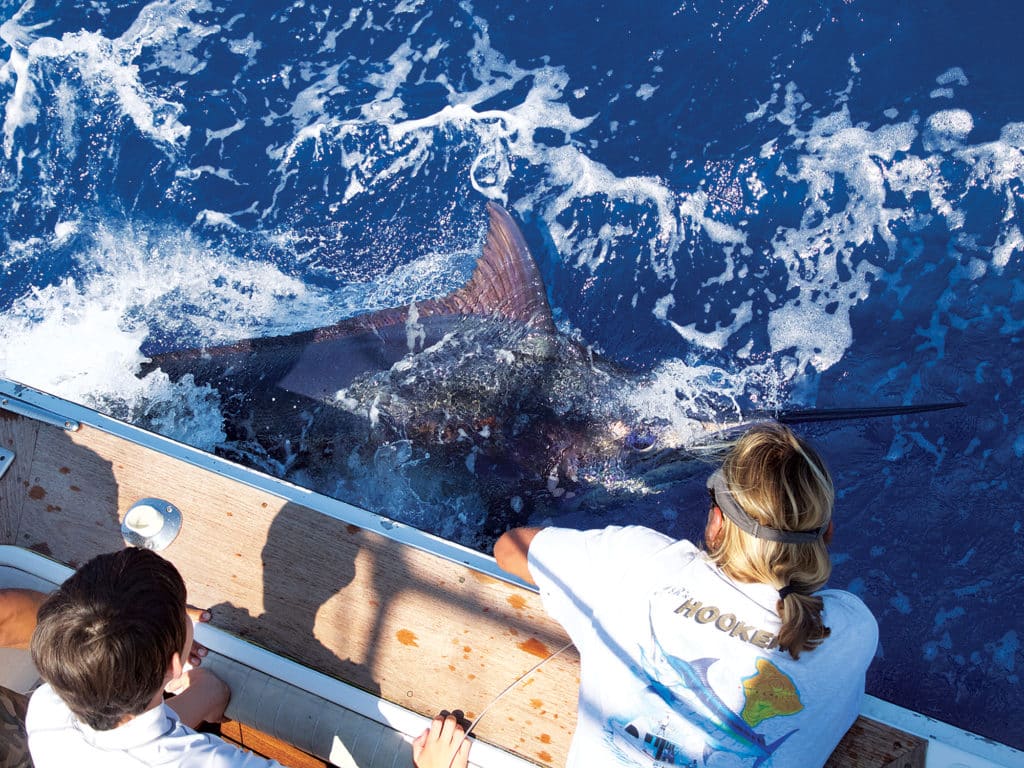
Hawaii’s marlin fishing grounds are especially suited to catching big fish from small boats, and the magical 100-fathom line is only a quarter of a mile offshore in several places. Hawaiian anglers have even boated granders on smaller boats than the Grace’s 18-footer. However, the prize for the tiniest grander catcher ever may be Fumio Murasaki’s Trixie. During the Kona Gold Jackpot Tournament in May 1986, Murasaki and two friends brought their overloaded 17-foot Boston Whaler into port with a 1,050-pound blue draped across the midship, head hanging off one side and tail over the other. No, they didn’t win the tournament — they weren’t even entered.
Consistent Fishing
Throughout the past six decades, annual grander numbers off Hawaii have remained remarkably consistent and generally average about two or three per year. Great years still pop up now and again with the same regularity as ever in the past. In fact, 2015 topped the all-time list with eight granders, and it also happened to be between two slow years, with only one 1,000-plus-pounder in each 2014 and 2016. For those who might lament over Kona’s glorious past, the 21st century has produced four of Kona’s best years ever: five granders in 2003 and seven each in 2001, 2012 and 2015. What’s more impressive is two of the big fish caught in 2015 topped the 1,300‑pound mark. If you are looking for modern-day marks to shoot for, Northern Lights boated a 1,309-pound blue in August 2015, and the skiff Rayna landed a 1,368-pounder in July of that year.
For those who might lament over Kona’s glorious past, the 21st century has produced four of Kona’s best years ever: five granders in 2003 and seven each in 2001, 2012 and 2015.
Sea temperatures vary little throughout the year, so it’s not surprising that granders have been caught here in every month of the year. Even so, historically, the best months for big fish have been March, April, May, June, July and August, which accounts for granders on all islands. Hawaii’s 1,000-plus-pound fish tend to be lone females that don’t travel as a group, and catching one grander rarely raises the expectations of finding another nearby or soon after. But, like all fishing rules, this one is sometimes broken. In 1987, Capt. Carl Schloderer boated a 1,103.5-pounder on July 25 followed by Capt. Kenny Auld’s 1,153-pound fish five days later. In 1990, Capt. Marlin Parker hauled in a 1,400-pound blue on May 5, and the skiff Sugar Hook followed on May 21 with a blue weighing 1,037 pounds. In 2002, Capt. Chuck Hupert caught a fish weighing 1,036 pounds on April 1, and Capt. Randy Parker followed with a 1,045-pounder a week later. In 2008, Capt. Rob McGuckin boated a 1,251-pounder on March 25, and captains Jeff Rogers and Rick Reger double-teamed a 1,056‑pound blue six days later.
But the most amazing double-grander catch happened during the 21st Annual Lahaina Jackpot Tournament. It was an El Niño year, which may be the reason that 1997 brought good fishing to the central Pacific. Capt. Russell Tanaka’s team on Magic saw the huge swirl of a big tail behind their lure and then heard the high-pitched scream of their reel as a 1,106-pound blue peeled line from their two-speed Penn 130. Nearby, Tanaka’s friend Rahn Yamashita on the boat Shirley Y was in touch with advice and good wishes. Just 20 minutes after Magic hooked up, a twin of Tanaka’s big grander hit one of the lures behind Shirley Y. The two boats stayed in touch on the radio as they battled their big fish, but the suggestions now sounded like “We’re in the same tournament, cut your line” and “No, you cut your line” instead of words of advice and encouragement.
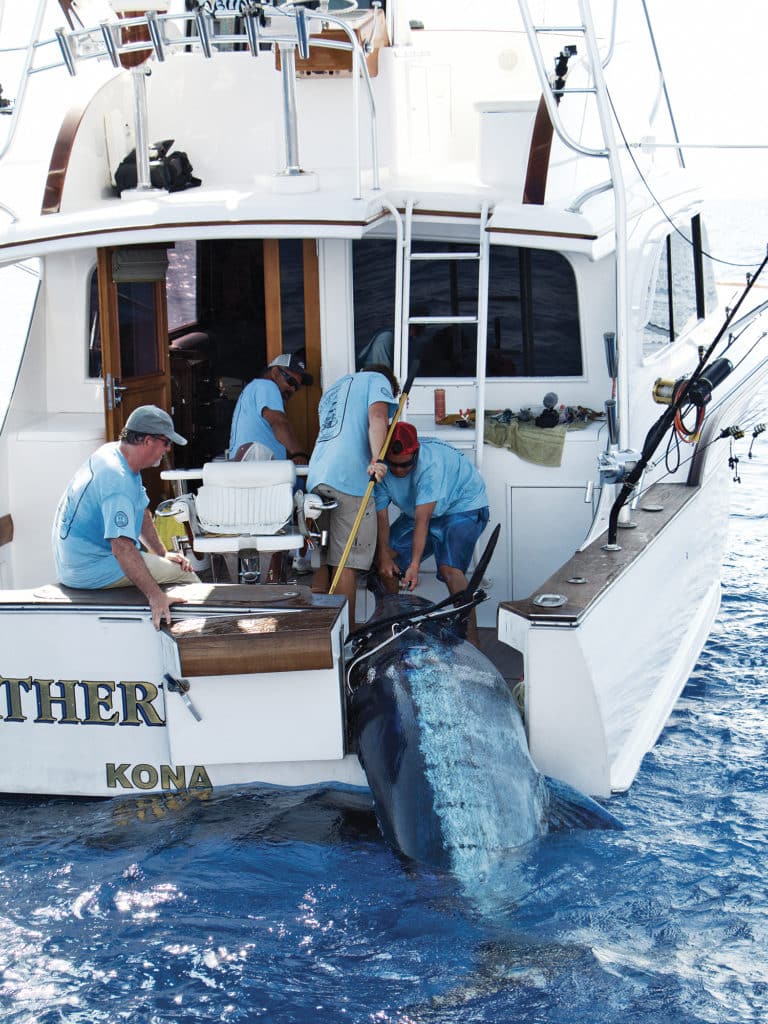
Both teams eventually boated their fish and returned to the scales where an unexpected turn of events determined the outcome. Yamashita had forgotten to tie his marlin’s mouth shut, so when they lifted it to be weighed, a spearfish and a mahimahi popped out of the fish’s mouth. Because a fish’s last supper counts as part of its weight, the partially digested meal counted. Even so, Shirley Y‘s fish lost out to Magic‘s 1,106-pounder by just half a pound.
But don’t call this a once-in-a-lifetime event. This was actually the second time in a tournament that Tanaka caught a grander to edge out another 1,000-pound fish. He did it back in 1982 aboard Mary I during the Pokai Bay Tournament when he boated his 1,032-pound winning blue the day after Sonny Rellin aboard Leila R caught the first grander, a 1,012-pounder, and everyone else had given up on any hopes of winning. After all, who would expect a grander to get beaten?
Certainly not Rellin. But a spearfish figured into the final score in this event too. Tanaka’s giant fish took the prize money for the largest marlin of the tournament, but it didn’t take the overall first-place award in the event. The Bonanza was a total-weight tournament, and Tanaka’s team came in second by virtue of a 29-pound spearfish that was caught by Leila R while Tanaka was fighting his behemoth.
So, if you’re taking notes on what conditions and circumstances make for great grander fishing in Hawaii, jot this down: 1982 was also an El Niño year — just like this one.
About the Author:
In a writing career spanning six decades, Jim Rizzuto has authored 15 books and thousands of articles about fishing in Hawaii.


